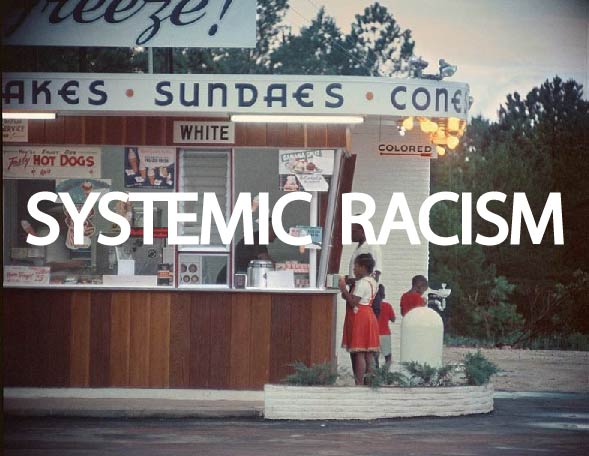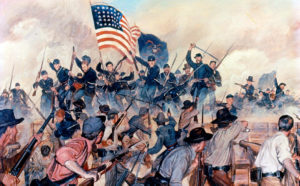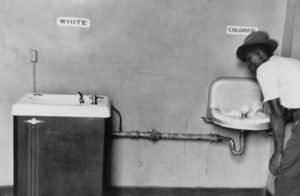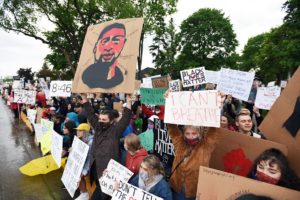
TERM OF THE WEEK: SYSTEMIC RACISM
A (not so) Brief History of systemic racism in America
On May 25 of 2020 a white police officer detained George Floyd, an unarmed Black man, for allegedly trying to use a counterfeit $20 bill. He was handcuffed, brought to the ground, and held in place for 8 minutes and 46 seconds by this officer kneeling with all of his weight on Mr. Floyd’s neck. George Floyd died while 3 other officers present at the scene stood with their hands in their pockets. Americans across the country were outraged. Yet another unarmed Black man murdered by a White police officer sparked nationwide protests and renewed conversations about racism in America. Many uninformed, privileged White people are shocked and have begun asking the question, “Why is this happening?” Well, the answer is because it has never stopped happening. We only need to slightly open the lid on the United States’ complicated history of systemic racism to understand.
In 1776, exhausted by the British monarchy’s taxation of Americans without giving them a voice in the government process and an increased control and restriction of the Colonists, a handful of revolutionaries pushed forward a philosophy to free themselves from tyranny. They wrote a statement to the King of England proclaiming, “We hold these truths to be self-evident, that all men are created equal” and continued to make the sweeping statement that the entire purpose of government is to ensure this is true. These words that introduce the Declaration of Independence have become a matter of national pride and stand as proof that the United States stands for equality.
This sounds beautiful. But, oddly, this document was signed by 57 people, 41 of whom owned slaves. Oddly, in a population of approximately 3.5 million colonists, more than 600,000 were enslaved because of the color of their skin. Oddly, the hypocrisy was lost on most. The institution of slavery was on the front line of many discussions as The United States began self-government, but it was always sidelined as a Southern problem and was never really addressed because there was a fear doing so would destroy the country before it was even formed.

THE CIVIL WAR TEARS THE US APART
In fact, The United States spent its first 84 years sidestepping the problem by striking compromise after compromise to keep slavery intact in the South so that northern industries could enjoy the benefits of high-quality, cheap cotton. With the election of Abraham Lincoln in 1860, no matter how much they had been coddled, Southerners saw their way of life threatened by an anti-expansionist platform and began to secede from the United States, sparking the deadliest war in American history, the Civil War. In 1865, after 600,000 Americans had killed each other, the South surrendered, and the end of the war brought amendments to the US Constitution banning slavery, extending citizenship to all freed slaves, and extending voting rights to all citizens (uhhhhh… except women). In order for southern states to be readmitted into the Union they had to ratify each of these amendments and demonstrate open voting. Very quickly, southern states started to see Black Americans elected to local government and changes to the status quo began.

SLAVERY BY ANOTHER NAME
It would be lovely if this were the beginning of the road to recovery. Instead, white supremacy was challenged and those people who believed in equality-for-some began their reign of aggression and intimidation. Voting rights were overturned by state legislatures through a systematic redefinition of the laws. “Grandfather Clauses” described who could and could not vote based on pre-1865 status – you now had to demonstrate you owned property before 1865 (no former slaves did, of course). Literacy Tests were a requirement to vote (though no whites were required to do so). Poll Taxes required a fee when appearing to vote, targeting Black Americans who had no opportunity to build wealth. The restrictions were astounding.
And, to further intimidate Black Americans, hate groups, like the Ku Klux Klan, were created. The KKK used scare tactics, at best, and, at worst, publicly lynched Black Americans. As immediately as 1866, state and local governments created laws known as Black Codes that were designed to empower White people and dictate to Black people where and when they could be. By the 1870s, these were followed by the most infamous of American laws that created a segregated nation, Jim Crow Laws. In the American South it was illegal for melanated Americans to use the same facilities as non-melanated Americans. You could not use the same water fountains, the same parks, the same train cabins, swim in the same bodies of water, nor marry if you weren’t of the same race. These laws became institutional practice and the racial wound in America festered in this system. Absolutely everything in Southern society revolved around these laws: Economic regulations around who could and could not borrow money from banks, social norms that permitted or didn’t permit people to mingle, and educational rights that restricted Black children from attending the same publicly funded schools as White children. Many Northern states, at best, kept their mouths shut, and others, like the state of Oregon, actually had written into their State Constitutions policies known as Exclusion Laws which made it illegal to be Black in the state. Local and state governments supported it, the United States Supreme Court upheld it, and systems continued.
White Supremacists were emboldened to continue their terror. Young Black men, like 14 year-old Emmett Till (1955), were accused of talking to young White women, chased down and killed for this suspicion. Fearful of Black congregations encouraging the promotion of civil rights, the KKK bombed the 16th Street Baptist Church (1963) killing 4 young Black girls. Crosses were burned, Black people were harassed, and lynchings were community events.
This is the climate that brought the Civil Rights Movement and the fight for integration to the rest of the world. Under the inspiration of Martin Luther King, Malcolm X, Angela Davis and many other groups like SNCC, NAACP, SCLC and the Black Panther Party, America’s youth stood up for justice and equality by staging Sit-Ins, Freedom Rides, marches, and peaceful protests all over the nation. With images of police brutality against peaceful protestors and images of vitriolic White Americans casting hatred upon respectful people being beamed into living room television sets, concerned Americans could no longer sit quietly. Many assembled and many marched for justice demanding change. In 1964, ninety-nine years after the Civil War had ended slavery, an American President (Lyndon B Johnson) finally signed into law The Civil Rights Act which guaranteed legal protection in the destruction of Jim Crow.
SYSTEMS ARE SLOW TO CHANGE
But, like a century before, there were many who were not ready to see the dismantling of a system that kept them in power. You can change the law, but changing entrenched racist beliefs and systems designed to keep those beliefs alive takes much much more. For the last 50 years, we have seen it slowly shift. With the integration of schools it has been normalized that all people exist and there are perspectives different to your own. With the re-implementation of voting rights, people of color (POCs) now have a powerful voice in American politics and are regularly focused on as a demographic for candidates to woo. With so much of American cultural output being influenced by Black Americans young people are finding their heroes and their inspirations through these voices.

THE SYSTEM PERSISTS
Unfortunately, in the midst of this change, in the midst of this painfully slow progression, the system still exists. Young, unarmed Black men are disproportionately murdered by police and vigilantes. Just 3% of the United States Senate is African American while upwards of 14% of the population identifies as such. Microaggressions, or acts of subtle discrimination, happen every moment of every day in this nation. Monuments to the Southern Civil War generals are still in public spaces and the Confederate flag that symbolizes that secession is still flown from windows and the back of trucks and worn on belt buckles throughout the country. People who want to deny the conversations need to happen declare themselves colorblind. People who cannot face this is a problem claim white privilege does not exist. And, our First Amendment still prioritizes the freedom to say whatever you want, over the freedom from those hateful and destructive words that advance racism, intolerance and white supremacy.
So, in 2020, with the extrajudicial murder of George Floyd by a police officer; on the heels of the extrajudicial murder of Ahmaud Arbery by white vigilantes, on the heels of a police invasion into the wrong home that ended with Breonna Taylor’s murder, on the heels of Eric Garner, and Trayvon Martin, and Michael Brown, and Sandra Bland, and Philando Castile, and the list goes on and on……. We have had enough. None of us can breathe while this system rocks us. Let us hold these truths to be self-evident: that all are created equal and BLACK. LIVES. MATTER.
GLOSSARY:
SYSTEMATIC RACISM: institutionalized laws, regulations, cultures within a societal system that discriminate against people (of color)
SYSTEMIC: applied throughout the entire system, society or institution
REVOLUTIONARY: a person who takes an active part in a revolution
EQUAL: the same or alike
DECLARATION OF INDEPENDENCE: document that announced the separation of 13 North American British colonies from Great Britain
EQUALITY: the condition of having the same political, social, and economic rights
SLAVE: a person owned by another and having no freedom of action or rights
COLONIST: a person who settles or colonizes an area
ENSLAVE: to put into slavery
INSTITUTION OF SLAVERY: the legal practice of keeping slaves
SLAVERY: a system by which people are owned by other people as slaves
ANTI-EXPANSIONIST: against a policy of increasing lands or power
CIVIL WAR: a war which is fought between different groups of people who live in the same country.
SURRENDER: to stop fighting because of defeat:
US CONSTITUTION: the fundamental law of the United States
BAN: to prohibit
CITIZENSHIP: the condition or status of a citizen, with its rights and duties
FREE: to set at liberty
VOTING RIGHT: the entitlement of a person to participate in public elections
THE UNION: The United States of America during the American Civil War
RATIFY: to give formal approval or consent to
AMENDMENT: a section that is added to a law in order to change it
BLACK AMERICAN: an American with black skin
WHITE SUPREMACY: the racist belief that white people are superior to people of other races
OVERTURN: to invalidate something already established
LEGISLATURE: the branch of government with the power to make laws
SYSTEMATIC: done according to plan, thoroughly and efficiently
GRANDFATHER CLAUSES: a set of clauses allowing for old rules to apply to existing situations and new rules only to future situations, used by some Southern states to continue to disenfranchise black Americans
LITERACY TEST: an examination to determine whether a person can read or right (in this case to see if someone meets the literacy requirements for voting)
POLL TAX: a fee paid for the right to vote
RESTRICTION: an official rule limiting what people are allowed to do
HATE GROUP: a group of people that advocates hatred, hostility, or violence towards members of a race, ethnicity, nation, religion or gender
KU KLUX KLAN: American white supremacist hate group whose primary target is African Americans
SCARE TACTIC: a way of achieving a particular result by frightening people
LYNCH: to kill someone without a legal trial usually by hanging, a common terror tactic used to scare black people
GOVERNMENT: the group of people with the authority to govern a country or state
BLACK CODES: a set of laws governing and restricting the conduct of (free) African Americans
SEGREGATE: to separate by race
JIM CROW LAWS: state and local laws that enforced racial segregation in the Southern United States
MELANATED: containing melanin, dark-skinned
NON-MELANATED: light-skinned
INSTITUTIONAL: relating to an institution
RESTRICT: to put a limit on
EXCLUSION LAWS: laws designed to regulate and define the rights of oppressed people
TERROR: fear and violence
ACCUSE: to charge with a crime or offence
CIVIL RIGHTS: set of rights designed to protect individuals from unfair treatment
CIVIL RIGHTS MOVEMENT: the struggle for justice and equality for African Americans (1950s and 1960s)
INTEGRATION: incorporation of people of different groups as equals into society or an organization
SNCC: Student Nonviolent Coordinating Committee, a civil rights group
NAACP: National Association for the Advancement of Colored, a civil rights group
SCLC: Southern Christian Leadership Conference, a civil rights group
BLACK PANTHERS PARTY: a civil rights group
JUSTICE: ethics, laws, and behaviour that are just, correct, and fair
SIT-IN: an organized protest in which demonstrators occupy a public place and refuse to leave it
FREEDOM RIDE: an organized ride (in buses, for example) by people demonstrating against racial segregation
MARCH: an organized procession as a protest or demonstration
PROTEST: an act of expressing objection to, disapproval of, or disagreement with some act or action
POLICE BRUTALITY: the use of undue or excessive force used by police officers, a civil rights violation
END: to stop
DISMANTLE: to take apart, reduce the power or purpose
ENTRENCH: to be firmly established
RACIST: a person who thinks that some people are inferior because of skin color, language, gender, or other factors
NORMALIZE: to become normal
PEOPLE OF COLOR: dark-skinned people
AFRICAN AMERICAN: an American with black skin, whose ancestors were born in Africa
DISCRIMINATION: the treatment of a person based on their skin, gender, age, ability, group, class or category
CONFEDERATE FLAG: A flag usually flown in South America to represent southern pride and heritage, but also white power and racism
SECESSION: the withdrawal of eleven southern states from the US Union in 1860, leading to the Civil War
WHITE PRIVILEGE: legal and systemic advantages given to white people
RACISM: belief that some people are inferior because of skin color, language, gender, or other factors
INTOLERANCE: unwillingness to accept views, beliefs, or behavior that differ from one’s own
BLACK LIVES MATTER: an organized movement dedicated to non-violent civil disobedience in protest to alleged incidents of police brutality


